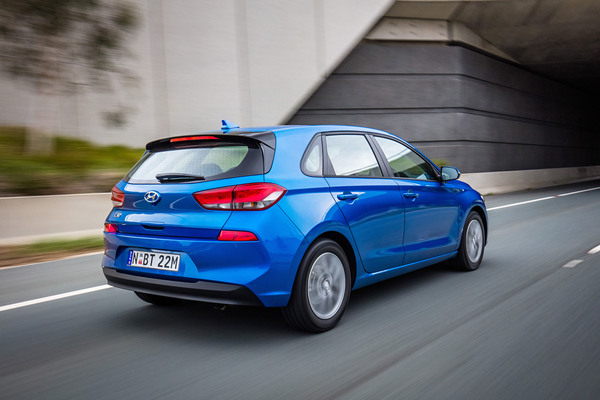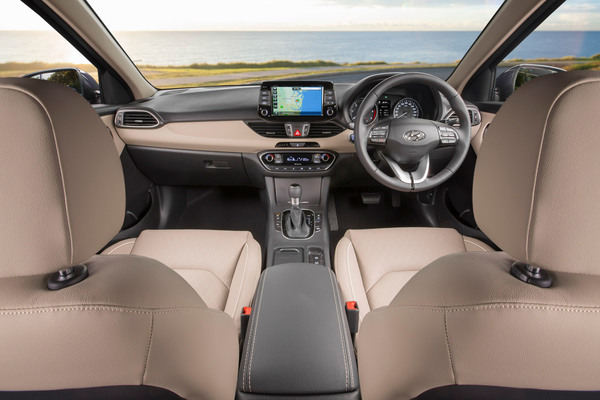
By Derek Ogden, Marque Motoring
Hyundai says it refuses to treat i30 owners as second-class automotive citizens and says it gives potential buyers of its third-generation goodies which are usually within the domain of more expensive models.
The entry-level Active variant, starting at $20,950 plus on-road costs, is $500 less than the model it replaces, despite having $2000 of extra standard features.
These include a fully integrated satellite navigation system with 8.0-inch touch screen display, Apple CarPlay and Android Auto compatibility and DAB+ digital radio.
It also has 16-inch alloy wheels, LED daytime running lights, automatic headlamps, hill-start assist and tyre pressure monitoring.
New i30 Active has a 2.0-litre direct-injection engine developing 13 kW more power and 28 Nm more torque than the 1.8-litre MPi engine it replaces.
As well as the i30 Active there are also Elite, Premium, SR and SR Premium variants. Alloy wheels debut as standard across the i30 range, with 16 and 17-inch alloys on comfort models (Active, Elite and Premium) and 18s on sports variants (SR and SR Premium).
The new i30’s on-road dynamics have benefited from exhaustive development for Australian conditions and driver preferences by Hyundai Australia’s chassis development team.
Greater use of lightweight high-strength steel has increased body rigidity over the outgoing model while achieving a 28 kg lighter body-in-white weight and use of aeronautical industry-style structural adhesives contributes to the i30’s lighter, stronger body.
The latest version of Hyundai’s Fluidic Sculpture styling introduces the company’s new cascading grille which, we are told, is designed to represent the flow of molten steel.
The grille is piano black with a contrasting chrome surround. In Elite, Premium and SR variants, the grille incorporates chrome-plated dots and a satin chrome surround.
A long(ish) bonnet is reinforced by a line running from the new-design headlights to the shapelier, Tucson-style tailgate. A roof-mounted shark-fin antenna and swept-back roof spoiler add a look of prestige.
This is amplified by machine-faced wheels for Elite and Premium, and sporty twin-spoke 18s on the SR and SR Premium variants. Both the latter boast twin exhaust tips in the blacked-out rear lower area.
The sporting intent is extended to the passenger cabin with exclusive sports front seats with extended bolsters offering greater lateral support and distinctive red seatbelts.
The 8.0-inch tablet-style multimedia display, mounted high on the dashboard, is within reach of both driver and front passenger.
Also in full focus of the driver is the Supervision dash cluster, featuring a 4.2-inch colour TFT LCD display, which displays a range of trip computer information, as well as system status and visual alerts from SmartSense and other safety systems.
It can also show turn-by-turn directions from the on-board satellite navigation. Supervision cluster is standard on SR, SR Premium, Elite, and Premium models.
Versatility carries through to the boot, where on SR, Elite, and Premium models the rigid floor can be mounted at two different heights.
The lower position maximises the 395-litre cargo volume, while the upper height allows the rear seats to be folded completely flat.
New i30 carries Hyundai’s comprehensive SmartSense driver assistance package offering significant passive and active safety technology upgrades.
These include autonomous emergency braking (AED) and forward collision warning, blind spot detection with lane change assist, driver attention alert, lane keeping assist and rear cross-traffic alert.
Smart cruise control and emergency stop signal are also in the mix.
Also across the i30 range is electronic stability control, which includes traction control, anti-lock braking with electronic brake-force distribution, brake assist and hill-start assist.
A rear-view camera with guidelines is complemented by rear park assist sensors, while Premium variants add four-sensor front park assist.
Seven airbags include driver and passenger airbags, front side (thorax) airbags, full-length side curtain airbags and driver’s knee airbag.
During a launch drive zig-zagging the border between NSW and Victoria near Albury a selection of new Hyundai i30s were put through their paces and generally lived up to expectations.
We began with the i30 Active and enjoyed the 2.0-litre petrol engine’s extra power and torque over its 1.8 predecessor to produce a spritely-yet-stress-free cruise in the country.
The 1.6D auto slowed the pace, and with a heavier feel to the front end, it also tended to be at the mercy of undulating surfaces where it gently bounced at times.
Settling into the sports seats of an SR manual lifted the spirits as the i30 provided a satisfying throaty engine note.
The Hyundai range is available for a test drive at Berwick Hyundai, 34 Kangan Drive, Berwick. Phone 9707 1212.
Model range
Hyundai i30 Active 2.0 GDi 6sp manual: $20,950
Hyundai i30 Active 2.0 GDi 6sp automatic: $23,250
Hyundai i30 Active 1.6 CRDi 6sp manual: $$23,450
Hyundai i30 Active 1.6 CRDi 7-DCT: $25,950
Hyundai i30 Elite 1.6 CRDi 7-DCT: $28,950
Hyundai i30 Premium 1.6 CRDi 7-DCT: $33,950
Hyundai i30 SR 1.6 T-GDi 6sp manual: $25,950
Hyundai i30 SR 1.6 T-GDi 7-DCT: $28,950
Hyundai i30 SR Premium 1.6 T-GDi 7-DCT: $33,950









